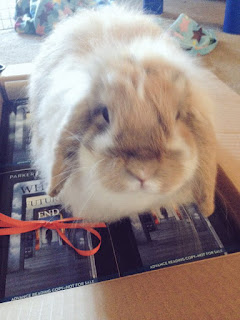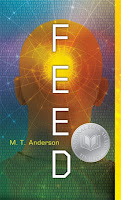 |
| Excerpt |
for Cynsations
Parker Peevyhouseis the first-time author of Where Futures End(Penguin/Kathy Dawson Books, 2016). From the promotional copy:
Five teens.
Five futures.
Two worlds.
One ending.
One year from now, Dylan develops a sixth sense that allows him to glimpse another world.
Ten years from now, Brixney must get more hits on her social media feed or risk being stuck in a debtors' colony.
Thirty years from now, Epony scrubs her entire online profile from the web and goes “High Concept.”
Sixty years from now, Reef struggles to survive in a city turned virtual gameboard.
And more than a hundred years from now, Quinn uncovers the alarming secret that links them all.
Five people, divided by time, will determine the fate of us all. These are stories of a world bent on destroying itself, and of the alternate world that might be its savior--unless it's too late.
Could you describe both your pre-and-post contract revision process? What did you learn along the way? How did you feel at each stage? What advice do you have for other writers on the subject of revision?
 |
| Parker Peevyhouse |
My agent, Ammi-Joan Paquette, also pointed out that the first story in the book had to be really gripping. Of course, every novel has to have an opening that grabs the reader, but that had to be especially true of Where Futures End, since the reader would only continue to the second story if s/he loved the first.
I worked really hard to revise the opening story before we sent out the manuscript on submission. But the feedback we got was that the first story still wasn’t working. The tone was too sad and dark, since the story dealt with a boy (Dylan) wrestling with the death of his brother; and Dylan was confusing, since he kept going back and forth on whether he had the ability to visit another world. I was pretty bummed about this feedback because I loved Dylan and his story, but I could see that the manuscript wouldn’t sell as-is.
I scrapped that first story and started over. I brought the dead brother back to life and made the plot focus on sibling rivalry. I created a more linear progression for Dylan’s investigation into whether he had the ability to visit another world, and I had the brother play a larger part in this mystery. To my surprise, this new version of the story felt even closer to what I had originally want to achieve. And it got a lot more interest from editors.
The editor who bought the novel, Kathy Dawson (who has her own imprint at Penguin), wanted me to make even deeper cuts. In the original version of the manuscript, Dylan is obsessed with a series of fantasy novels about the Lookingland, a magical realm Dylan thinks he can visit. Throughout the novel, other characters also try to access the Lookingland, so it became an element that tied together the separate stories that make up Where Futures End. Kathy suggested I cut out the Lookingland entirely; she thought it was too confusing, one more thing for the reader to keep track of in an already intricate novel. But how in the world would I then tie all of Where Futures End together?
 |
| Parker's assistant, Arya |
In the second part of Where Futures End, Dylan’s stories come to the public’s attention. In the third part, we see that books and movies have been made from Dylan’s stories. In the fourth part, a main character makes his living playing a video game based on Dylan’s stories. And in the fifth part, the stories take on a life of their own…
It was painful to make all of those deep cuts. I wasn’t always sure I should make such huge changes to my original vision! But I took the advice of my agent and did my revisions in a separate document so that I always had the option of reverting to the original manuscript.
That helped me make bold changes, and in the end, I felt the new versions of the manuscript were better than the old versions.
It helps to have an agent and an editor who are so insightful with their revision suggestions, but I also recommend taking chances with revisions, knowing you can always go back to what you originally wrote if those revisions don’t work for you.
As a science fiction writer, what first attracted you to that literary tradition? Have you been a long-time sci-fi reader?
 Does anyone else remember “poot” from My Teacher Fried My Brains by Bruce Coville (Aladdin, 1991)? I loved that crazy-weird stretchable pet when I was in grade school. And I was fascinated by the tesseracts in A Wrinkle In Time by Madeleine L’Engle (Farrar, Straus & Giroux, 1963).
Does anyone else remember “poot” from My Teacher Fried My Brains by Bruce Coville (Aladdin, 1991)? I loved that crazy-weird stretchable pet when I was in grade school. And I was fascinated by the tesseracts in A Wrinkle In Time by Madeleine L’Engle (Farrar, Straus & Giroux, 1963).When I was a kid, if there was a book in my library about something strange, I took it home.
Those books inspired me to write my own weird stories about kids visiting alternate realities and wielding supernatural powers.
Reading and writing science fiction was the only thing that could feed my ever-hungry imagination.
What drew me to science fiction as a kid were the strange ideas, the mind-benders, like Meg Murray talking about how time is the fourth dimension.
 Where Futures End makes use of the tropes I’ve loved reading about from a young age: alternate universes, time distortion, psychic abilities. But I’ve also grown to love how science fiction explores personal interactions and cultural changes. I wanted Where Futures End to explore culture in the same way Feed by M. T. Anderson (Candlewick, 2002) does, and to explore relationships in the same way that How I Live Now by Meg Rosoff (Penguin, 2004) does.
Where Futures End makes use of the tropes I’ve loved reading about from a young age: alternate universes, time distortion, psychic abilities. But I’ve also grown to love how science fiction explores personal interactions and cultural changes. I wanted Where Futures End to explore culture in the same way Feed by M. T. Anderson (Candlewick, 2002) does, and to explore relationships in the same way that How I Live Now by Meg Rosoff (Penguin, 2004) does.Science fiction, more than any other genre, lends enough distance to gain new perspectives, and that’s the main reason I still love the genre.
Add a Comment




